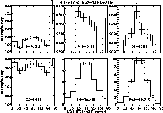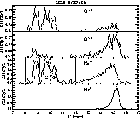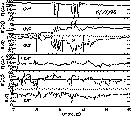
A new, temporarily confined population in the polar
cap during the August 27, 1996 geomagnetic field distortion period
Jiasheng Chen, Theodore A. Fritz, Robert B. Sheldon, Harlan
E. Spence, and Walther N. Spjeldvik
Boston University Center for Space Physics
725 Commonwealth Av, Boston, MA 02215i
Joseph F. Fennell
The Aerospace Corporation, Los Angeles, CA
Stefano Livi
Max-Planck-Institut fuer Aeronomie, 37189 Katlenburg-Lindau, Germany
October 1997
On August 27, 1996, a two-hour energetic heavy ion event (~ 1 MeV)
was detected at 8:25 UT at apogee (~ 9 Re and an invariant
latitude of ~ 80o), by the Charge and Mass Magnetospheric
Ion Composition Experiment onboard POLAR. The event, with a maximum
spin averaged peak flux of ~ 150 particles/(cm2-sr-s-MeV),
showed three local peaks corresponding to three localized regions; the
ion pitch angle distributions in the three regions were different from
an isotropic distribution and different from each other. No
comparable flux was observed by the WIND spacecraft. The appearance
of lower energy He++ and O++... during the event
period indicates a solar source for these particles. From region 1 to
2 to 3, the helium energy spectra softened. A distorted magnetic
field with three local minima corresponding to the three He peak
fluxes was also observed by POLAR. A possible explanation is that the
energetic He ions were energized from lower energy helium by a local
acceleration mechanism that preferred smaller rigidity ions in the
high altitude polar cusp region.
Introduction
The investigation of geomagnetically trapped heavy ions began at the
1960's [Krimigis and Van Allen, 1967; Fritz and Krimigis, 1969].
Axford [1970] suggested a direct injection from the polar
regions with subsequent acceleration; and Cornwall [1972] and
Spjeldvik and Fritz [1981a,b] discussed and modeled charge
exchange, Coulomb collisions, and radial diffusive transport.
Recently, a trapped 3He species in the inner belt was
observed by the CRRES satellite [ Chen et al., 1994, 1996a,b],
and an origin of these ions in energetic proton interactions with the
residual atmosphere was suggested [Chen et al., 1996a,b;
Selesnick and Mewaldt, 1996]. However, all of the
aforementioned discussions regarding sources are limited to within the
known radiation belts either near the equator or at lower
altitude.
POLAR was launched on February 24, 1996 with a 1.8 X 9 Re
(Earth radius) polar orbit, which has an inclination of 86o
and period of 18 hours. The spacecraft, so far, samples high altitude
regions in the north and low altitudes in the south and spins with a
period of about 6 seconds. The Charge and Mass Magnetospheric Ion
Composition Experiment (CAMMICE) onboard POLAR consists of two
sensors, the Heavy Ion Telescope (HIT) and the Magnetospheric Ion
Composition Sensor (MICS), designed to measure the charge and mass
composition within the magnetosphere over the energy range of 1 KeV/e
to 60 MeV/ion, to determine the fluxes of various ion species and
their relative abundances and to seek to identify mechanisms by which
these ions are energized and transported from their source populations
within geospace. The HIT sensor uses a three-element solid-state
detector telescope to measure the rate of energy loss and the ion's
total incident energy, and this permits an unambiguous determination
of the ion mass and incident energy over the energy range from 100
KeV/ion to 60 MeV/ion. There are also some discrete discriminators on
each detector to create data response channels that can be accumulated
in a manner identical to a number of previous instruments of this type
flown as part of the science payload of Explorer 45, ATS-6, Viking,
and CRRES [Fritz and Cessna, 1975; and Fritz et al.,
1985]. The data are then sampled every 1/16 of a spin; that is, 16
sectors in each spin.
A Special Event: Observation of August 27, 1996
Figure 1 displays the spin averaged passband integrated flux
of helium (~ 0.52-1.15 MeV) measured by the HIT sensor during August
27, 1996. At 8:25 UT when the POLAR spacecraft was 9 Re from
the Earth with MLAT ~67o, and MLT ~ 14.7 hours, the HIT
sensor detected a sudden increasing He flux. This energetic helium
event lasted more than two hours with a peak spin averaged flux of
about 150 particles/(cm2-sr-s-MeV). The day-side and high
latitude location, the energy, and the two-hour time period indicate
that this is a very special event and is indeed very surprising
because it is unexpected theoretically [e.g., Ilyin et al.,
1986; Chen et al., 1996b]. About 3.5 hours after event onset,
an increasing helium ion flux was also measured all the way into L =
5.

Figure 1: Spin averaged integral flux of helium measured by the
CAMMICE/HIT sensor during August 27, 1996. At the bottom, the
descriptive ephemeris parameters are the L-shell values, radial
distance of the POLAR (R), magnetic latitude (MLAT), and magnetic
local time (MLT), respectively.
New Temporarily Confined Population Over the Polar Cap
A closer look at Figure 1 indicates that the particle fluxes in this
event had three different local peaks corresponding to three different
regions: before 9.1 UT, 9.1-10 UT, and after 10 UT. Figure 2 plots
the pitch angle distributions of the helium ions in counts per sample
number. The three different regions are showed in the three top
panels. In Figure 2, each bin is azimuthally 22.5 degrees wide. The
HIT sensor has a small field of view (~ 12o conical
perpendicular to the spin axis) so that for particles trapped in the
radiation belt it will detect a maximum counting rate when its look
direction is perpendicular to the magnetic field vector. This is what
the bottom-right two panels (14-15.5 UT and 15.5-15.7 UT) show,
characteristic of the trapped populations within the radiation belts.
In contrast, for an isotropic distribution, a fairly straight
horizontal line is expected, independent of HIT look direction as
shown in the 12-14 UT panel where, to within the uncertainties, an
essentially isotropic distribution of the helium ions was observed.
The latter is expected since they are located at L = 10-19 range
beyond the stable trapping region for ~ 1 MeV helium.

Figure 2: Counts/sample number vs. the computed pitch angles for ~
0.52-1.15 MeV helium are displayed as a function of time and
correspond to the different L regions showed in Fig. 1. The vertical
bars indicate the statistical errors.
Of particular interest is the top three panels in Figure 2, which
shows that the ion pitch angle distributions of this event in the
three regions are different from each other, and all of them were
different from an isotropic distribution, indicating a temporarily
confined component.
Both Figures 1 and 2 show that the observed energetic helium ions in
the polar cap region are spatially separated from those close to the
equator in the radiation belt. A natural question is what is the
original source for the energetic population in the polar cap region
and what maintains the confining topology?
The counting rates of lower energy ions measured by the MICS sensor
are shown in Figure 3. The figure exhibits large amounts of lower
energy He++ and O++... during the two-hour event
period, thus suggesting a solar wind source for the particle fluxes we
report. Another interesting point is that the He++ panel
also displays a different peak in each of the three regions in this
event. Comparing Figure 1 with Figure 3, one finds that the helium
energy spectra become softened from region 1 to 2 to 3, because the
He++ ions measured by the MICS are in the energy range of
about 1-200 KeV/e. The key point is that the observed helium ions in
this two-hour event most likely are from the same solar wind source
but that they exhibit different energy spectra in different regions,
which suggests a further local acceleration mechanism.

Figure 3: Counting rates measured by the MICS sensor are ordered from
top to bottom being O++..., O+,++,
He++, and He+,
respectively. The numbers of 1, 2, and 3 within the vertical dashed lines
in He++ panel mark the three different regions in this event.
The measurements strongly suggest that the energetic ions in the polar
cap constitute a new temporarily confined heavy ion population that
was controlled by some local accelerating and confining mechanism.
This high latitude discovery warrants further investigation.
Discussion
Another way to determine the source of the observed energetic helium
ions is using the isotopic ratio. The effective solar source
3He/4He ratio is expected to be a few parts in
104 in the solar corona and in the solar wind [e.g.,
Axford, 1970; Geiss et al., 1970; Geiss and
Reeves, 1972], whereas the same ratio was less than one part in
106 for plasmas associated with the ionosphere
[Axford, 1970]. At L > 5, the direct event mode of the HIT
sensor detected 21 helium ions at energy of about 1.5-4.5 MeV, among
them five are 3He. Although this constitutes rather low
count statistics, if they were from solar wind accelerated by
interplanetary shocks, one would expect the HIT to detect only 0.01
3He not five, that is more than two orders of magnitude
less than what was observed. Therefore, if solar wind is the source
then there would possibly be a local acceleration mechanism that
preferred lower rigidity ions.
The CRRES spacecraft observed a significant amount of 3He
at L < 4 [Chen et al. 1994], which can be attributed to the
energetic proton interactions with the residual atmosphere [Chen et
al., 1996a,b; Selesnick and Mewaldt, 1996]. However,
within the classical radiation belts the measured
3He/4He ratios at 51-86 MeV/nucleon increased
with the decreasing L, and that is different from the present HIT
result (3He/4He decreased as L decreases).
Thus, by spatial location and radial gradient, proton interactions by
nuclear reactions in the atmosphere is not likely to be the source for
the helium ions reported here.
For small (impulsive) solar energetic particle (SEP) events at an
energy of ~ 1-4 MeV/nucleon, Reames [1993] reported very high
3He/4He ratios ranging from 0.1 to 20 in those
events. These large ratios were explained by a model in which the
3He ions were preferentially accelerated by a
wave-resonance mechanism [Fisk, 1978; Temerin and Roth,
1992] during solar flares. Data from the WIND spacecraft on August
27, 1996 showed that : (1) the solar wind ion density decreased from
15/cm3 at 8 UT to 10/cm3 at 10 UT; (2) the solar
wind speed fluctuated between 430 km/s and 455 km/s during the
two-hour period; (3) a small 20-minute SEP event was detected at 4 UT
with a peak helium flux of 22 particles/(cm2-sr-s-MeV/n) at
0.32-0.64 MeV energies. While in the above small SEP event the helium
energy is comparable to that in Figure 1, this SEP event occurred 4.5
hours earler than the polar event, and both the time period and peak
flux in the SEP event were almost one order of magnitude less than
that in the polar event. In other words, no simultaneous comparable
flux was observed by the WIND spacecraft, and this seems to rule out
the solar flare as a direct and transient source.
To gain an insight into what factors are important to confine MeV ion
fluxes in the polar region, in Figure 4 we plot the magnetic field
direction angles and magnitude during the period of interest in the
Geocentric Solar Magnetospheric (GSM) polar coordinates. Figure 4
shows that within the two-hour event period the geomagnetic field
(GMF) experienced strong distortions, which have no obvious temporal
association in the IMF. The WIND spacecraft was in a position about
90 Re from the Earth during the event period, and one would
expect a 22 minutes delay with the observed solar wind speed for any
causal variation. To confine energetic ions, two local maxima of the
geomagnetic field intensities are required or at least a localized
minimum field intensity. Indeed, Figure 4 shows three local GMF
B-minima, and this may substantiate the idea of the observed
temporary confinement.

Figure 4: Magnetic field directions and magnitude, in the GSM polar
coordinates, for both the GMF (top three panels), measured by POLAR,
and the IMF (bottom three panels), measured by WIND, where Bp
is the longitude; Bt, the latitude; and B, the
magnitude. The numbers of 1, 2, and 3 within the vertical dashed
lines mark the three different regions in the event.
The MICS data indicate that POLAR was in a region dominated by
magnetosheath plasma. The orbit showed that in this time interval,
POLAR was just above the nominal position of the cusp. The IMF, as
shown in Figure 4, was northward for most of the interval, which would
move the cusp region northward and possibly open up the ``throat'' of
the field topology making the magnetosheath plasma accessable to
POLAR. A detailed inspection on GMF B panel in Figure 4 and
He++ panel in Figure 3 reveals that the three local GMF
minima are anticorrelated with the local He++ peak fluxes.
However, this is not the case for the higher energy helium measured by
the HIT.
Summary and Conclusions
The HIT sensor onboard the POLAR spacecraft observed a two-hour
energetic heavy ion event (~ 1 MeV) at 8:25-10:25 UT on August 27,
1996 near apogee (~ 9 Re and an invariant latitude of ~
80o). Our principal conclusions are the following:
- Unique observation of very energetic helium in vicinity of day-side
polar cusp, which showed three different helium peaks (or regions).
- The helium pitch angle distribution in these three regions are
different from each other, and all of them are different from an isotropic
distribution.
- The event had a peak spin averaged flux of nearly 150
particles/(cm2-sr-s-MeV). No comparable flux was observed
by the WIND spacecraft.
- The appearance of the lower energy
He++ and O2+,3+... indicates a likely solar
source for this event.
- From region 1 to 2 to 3 in Figure 3,
the helium energy spectra progressively softened.
- A
distorted magnetic field with three local minima corresponding to the
three helium peak fluxes was observed by POLAR during this two-hour
period.
One possible explanation of the event is that these ions were
energized from lower energy helium by a local acceleration mechanism
that preferred smaller rigidity ions. A new temporarily confined and
solar originated ion population (up to at least 2 MeV) in the polar
cusp, which exists only during GMF distortion periods, has been
observed.
Acknowledgements
We want to
acknowledge the contribution of B. Laubscher, R. Hedges, R. Vigil, and
G. Lujan on the CAMMICE HIT sensor system at the Los Alamos National
Laboratory; R. Koga, P. Lew, N. Katz, and B. Crain on the HIT data
processing unit at the Aerospace Corporation; and the admistrative
support and interest provided by D. Cobb at the Los Alamos National
Laboratory. We are grateful to R. Lepping for providing us the WIND
IMF data and C. T. Russell for the POLAR GMF data. This research was
supported by NASA grant NAG5-2578.
-
Axford, W. I., On the origin of radiation belt and auroral primary
ions, in Particles and Fields in the Magnetosphere, edited by
B. M. McCormac, p. 46. D. Reidel, Dordrecht, Netherlands, 1970.
- Chen, J. et al., Energetic helium particles trapped in the
magnetosphere, Geophys. Res. Lett, 21, 1583, 1994.
- Chen, J. et al., Geomagnetically trapped energetic helium
nuclei, in Workshop on the Earth's Trapped Particle
Environment (Taos), edited by G. D. Reeves, Amer. Instit. of
Phys. Conf. Proc. No. 383 (Woodbury, NY), AIP Press, p. 161-167,
1996a.
- Chen, J. et al., Energetic helium isotopes trapped in the
magnetosphere, J. Geophys. Res., 101, 24787, 1996b.
-
Cornwall, J. M., Radial diffusion of ionized helium and protons: A
probe for magnetospheric dynamics, J. Geophys. Res., , 77,
1756, 1972.
- Fisk, L. A., 3He-rich flares: A possible
explanation, Astrophys. J. , 224, 1048, 1978.
- Geiss, J. et al., Apollo 11 and 12 solar wind composition
experiments: Fluxes of He and Ne isotopes, J. Geophys. Res.,
75, 5972, 1970.
- Geiss, J., and H. Reeves, Cosmic and solar system abundances
of deuterium and helium-3, Astronomy and Astrophys., 18, 126,
1972.
- Krimigis, S. M., and J. A. Van Allen, Geomagnetically
trapped alpha particles, J. Geophys. Res., 72, 5779, 1967.
- Fritz, T. A., and J. R. Cessna, ATS-6 NOAA low energy proton
experiment, IEEE Trans. Aerospace and Electronic Systems, AES-11,
No. 6, 1145, 1975.
- Fritz, T. A., and S. M. Krimigis, Initial observations of
geomagnetically trapped protons and alpha particles with OGO 4,
J. Geophys. Res., 74, 5132, 1969.
- Fritz, T. A. et al., The mass composition instruments
(AFGL-701-11), in CRRES/SPACERAD Experiment Descriptions,
eds. M. S. Gussenhoven, E. G. Mullen, and R. C. Sagalyn, Air Force
Geophysics Laboratory Report AFGL-TR-85-0017 (Hanscom AFB, MA),
p. 127, 1985.
- Ilyin, V. D., I. V. Ilyin, and S. N. Kuznetsov, Stochastic
instability of charged particles in a geomagnetic trap, Cosmic
Res. 24, 75, 1986.
- Reames, D. V., Non-thermal particles in the interplanetary
medium, Adv. Space Res., 13 (No. 9), 331, 1993.
- Selesnick, R. S., and R. A. Mewaldt, Atmospheric production
of radiation belt light isotopes, J. Geophys. Res., 101,
19745, 1996.
- Spjeldvik, W. N., and T. A. Fritz, Energetic heavy ions with
nuclear charge Z >= 4 in the equatorial radiation belts of the Earth:
magnetic storms, J. Geophys. Res., 86, 2349, 1981a.
- Spjeldvik, W. N., and T. A. Fritz, Observations of energetic
helium ions in the Earth's radiation belts during a sequence of
geomagnetic storms, J. Geophys. Res., 86, 2317, 1981b.
- Temerin, M., and I. Roth, The production of 3He
and heavy ion enrichments in 3He-rich flares by
electromagnetic hydrogen cyclotron waves, Astrophys. J. , 391,
L105, 1992.
TOC Comments?
r*bs@rbsp.info
(due to spamming, delete the asterisk)




